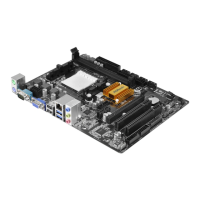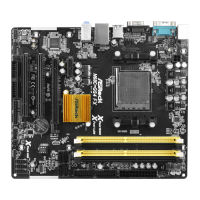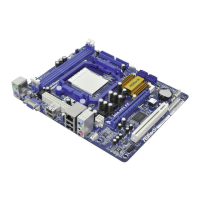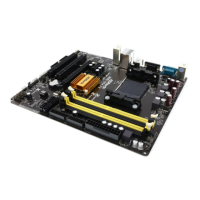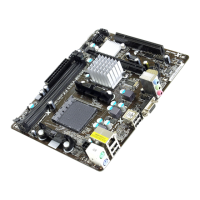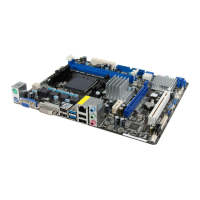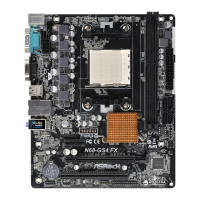
Do you have a question about the ASROCK N68-GS4 FX R2.0 and is the answer not in the manual?
| Non-ECC | Yes |
|---|---|
| Memory channels | Dual-channel |
| Memory slots type | DIMM |
| Supported memory types | DDR3-SDRAM |
| Maximum internal memory | 16 GB |
| Supported memory clock speeds | 1066, 1333, 1600, 1866 MHz |
| System bus rate | 2 GT/s |
| Processor socket | Socket AM3+ |
| Processor manufacturer | AMD |
| Compatible processor series | AMD Phenom II X2, AMD Phenom II X3, AMD Phenom II X4, AMD Phenom II X6 |
| Processor system buses supported | 1000 MHz |
| USB 2.0 connectors | 2 |
| Number of SATA connectors | 4 |
| USB 3.2 Gen 1 (3.1 Gen 1) connectors | - |
| RAID levels | 0, 0+1, 1, 5, JBOD |
| Supported storage drive interfaces | SATA II |
| USB 2.0 ports quantity | USB 2.0 ports have a data transmission speed of 480 Mbps, and are backwards compatible with USB 1.1 ports. You can connect all kinds of peripheral devices to them. |
| USB 3.2 Gen 1 (3.1 Gen 1) Type-A ports quantity | 0 |
| LAN controller | Realtek RTL8211E |
| Ethernet interface type | Fast Ethernet, Gigabit Ethernet |
| Certification | FCC, CE, WHQL, ErP/EuP, ErP/EuP |
| Component for | PC |
| Motherboard chipset | NVIDIA nForce 630a |
| PC health monitoring | CPU |
| Audio output channels | 7.1 channels |
| Motherboard form factor | ATX |
| Motherboard chipset family | NVIDIA |
| USB version | 2.0 |
| Trial software | Google Chrome Browser and Toolbar |
| Cables included | SATA |
| Graphics card | GeForce 7025 |
| DirectX version | 9.0 |
| Maximum resolution | 1920 x 1440 pixels |
| Maximum graphics card memory | 256 MB |
| Depth | 183 mm |
|---|---|
| Width | 221 mm |
Details on installing supported Microsoft Windows operating systems on the motherboard.
Information about drivers and utilities available on the motherboard's support CD.
Lists the items included in the ASRock N68-GS4/USB3 FX R2.0 motherboard package.
Detailed technical specifications for the motherboard, including platform, CPU, chipset, memory, and expansion slots.
Diagram and identification of key components and connectors on the motherboard.
Description and layout of the rear panel input/output ports and their functions.
Important safety and handling precautions to take before installing motherboard components.
Step-by-step guide for correctly installing the CPU into the motherboard socket.
Instructions for mounting the CPU heatsink and fan, and connecting the fan cable.
Procedure for installing DDR3 memory modules into the DIMM slots for dual-channel operation.
Information on the types and installation of PCI and PCI Express expansion cards.
Explanation of jumper configurations, including the Clear CMOS jumper and its function.
Details on various onboard headers and connectors like SATA, USB, and Print Port.
Overview of the BIOS Setup Utility, how to enter it, and general usage notes.
Description of the main menu bar options available within the BIOS Setup Utility.
Explanation of the keyboard keys used for navigating and operating the BIOS Setup Utility.
Display of the main BIOS screen, showing system overview and basic configuration options.
Section for configuring overclocking features, CPU frequency, and other performance-related settings.
Access to advanced system configurations including CPU, Chipset, ACPI, Storage, and PCI/PnP settings.
Detailed CPU settings such as Cool 'n' Quiet, Secure Virtual Machine, and Enhance Halt State.
Configuration options for onboard devices like HD Audio, LAN, and the primary graphics adapter.
Settings related to ACPI (Advanced Configuration and Power Interface) features like Suspend to RAM and power loss restore.
Configuration options for onboard SATA controllers, including SATA operation mode and RAID settings.
Settings for PCI and PnP (Plug and Play) configurations, including latency timers and bus mastering.
Configuration settings for the Super IO chip, including serial and parallel port addresses and modes.
Settings for USB controllers, including USB 2.0 support, legacy support, and power on options.
Monitoring system hardware status like CPU temperature, fan speeds, and voltages.
Configuration of boot devices, boot priority, and boot-up options like Num-Lock.
Setting and managing supervisor and user passwords for system security.
Options for saving or discarding changes, loading defaults, and exiting the BIOS Setup Utility.
Details on installing supported Microsoft Windows operating systems on the motherboard.
Information about drivers and utilities available on the motherboard's support CD.
